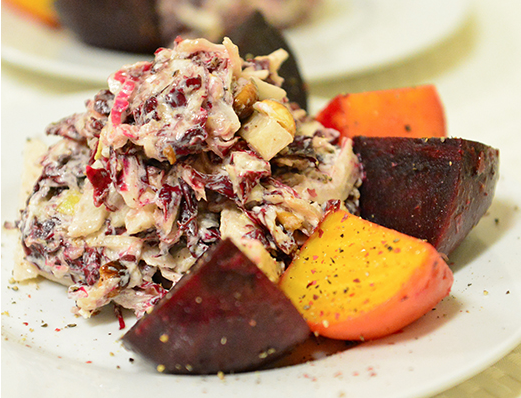How to Select Asian Pears
- Choose Asian pears that have a round, apple-like shape and are crisp and firm but not overly hard. Asian pears stay firm even when ripe, so avoid those that have begun to soften.
- Look for Asian pears that are free of any soft spots or bruising, as these will store poorly.
- Avoid pears that are not fully ripe. Asian pears should fully ripen on the tree before being picked.
When are Asian Pears in Season?
Asian pears, also known as nashi fruits, are seasonal fruits that come into harvest in late summer and early fall. In the Northern Hemisphere, Asian pears typically come into season from August to October while in the Southern Hemisphere they can be found from February to April.
Varieties of Asian Pears
There are more than one hundred varieties of asian pears available today, all with unique flavor profiles that range from sweet to tart. Some popular asian pear varieties include Hosui, Shinsui, Nijisseiki, Olympic, and Shinseiki.
Hosui asian pears are large, yellow-green fruits with a juicy yet crisp texture. The flavor is sweet, mild, and highly aromatic.
Shinsui asian pears are smaller than Hosui varieties but have an intense sweetness that makes them incredibly popular. They’re also light yellow in color and have a very juicy texture.
Nijisseiki asian pears are large, round fruits that are yellow-green in color. The flavor is sweet but delicate, making them perfect for eating as-is or using as an ingredient in desserts.
Olympic asian pears are small, yellow-green fruits that have a mild and sweet flavor. They’re often as crunchy as apples and make a great addition to salads or as a snack.
Shinseiki asian pears are large, light yellow in color, and have a sweet yet slightly tart flavor. They’re juicy but still have a slightly crunchy texture, making them ideal for eating as-is or as an ingredient in recipes.
Asian Pears Nutrition Facts & Benefits
The nutritional content of 1 Asian pear provides,
- approx 116 calories
- 0 grams of fat
- 1 gram of protein
- 29 grams of carbohydrates
- 19 grams of natural sugar
- 10 grams of fiber
Here are just a few of the many ways that asian pears can benefit your health:
- Fiber: Asian pears are a good source of dietary fiber, which helps to keep your digestive system running smoothly by regulating bowel movements and preventing constipation.
- Antioxidants: The high levels of antioxidants found in asian pears may help to reduce your risk of heart disease by fighting inflammation and preventing the buildup of cholesterol-rich plaque on artery walls.
- Vitamin K: Asian pears are a good source of vitamin K, which is essential for bone health as it helps to regulate calcium metabolism in the body and improve bone mineral density.
- Vitamin C: The Vitamin C content in asian pears helps boost immunity as it is involved in white cell production, as well as helping protect against cellular damage caused by free radicals.
How to Store Asian Pears
How To Store Fresh Asian Pears: Asian pears keep well at room temperature and even longer in the refrigerator. Store Asian pears at room temperature for up to 1 week or more in a bowl or on your countertop out of direct sunlight. To store Asian pears in the refrigerator, simply place them on a shelf or in a fruit drawer, if available, and avoid crushing or damaging them during storage. Asian pears will keep for up to 3 months in the refrigerator.
How To Freeze Asian Pears: Flash freezing is the best method for keeping Asian pears in your freezer, though freezing will change their texture. Start by washing and slicing the Asian pears into small slices. Arrange them on a single layer on a baking sheet and freeze them for 3 to 4 hours or until solid. Transfer the slices into a container or freezer-safe plastic bag for long-term storage. Asian pears will keep for up to 8 months in the freezer.
How to Prepare Asian Pears
Asian pears are a delicious, crunchy fruit that can be used as a snack, as part of a salad, or as an ingredient in cooked dishes. Here are some tips for prepping asian pears:
- Slice asian pears into thin slices for toppings to salads or as a refreshing snack.
- To further sweeten and soften an asian pear, you can also poach it. Cut the asian pear into cubes and in low-medium water. Feel free to consider cloves, cinnamon sticks, star anise, ginger, and/or honey as additional ingredients. Poach asian pears for about 15 minutes until tender.
- Use asian pears as an ingredient in cooked dishes like stir-fries. Thinly slice asian pears and add near the end of cooking.
- Make asian pear compote by simmering asian pears with sugar, water, cinnamon sticks and a bit of lemon juice for about 30 minutes until thickened. This makes a great topping for yogurt or ice cream!
- Try grilling asian pears with honey and spices like cinnamon and nutmeg over medium heat until softened. Serve as is or top with some creamy Greek yogurt.
No matter how you prepare asian pears, they are sure to be a crowd pleaser!



